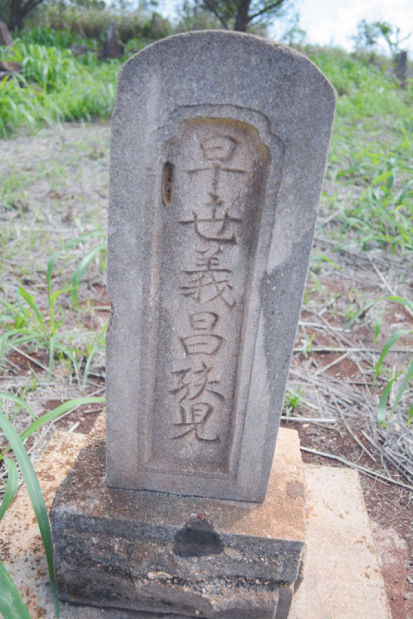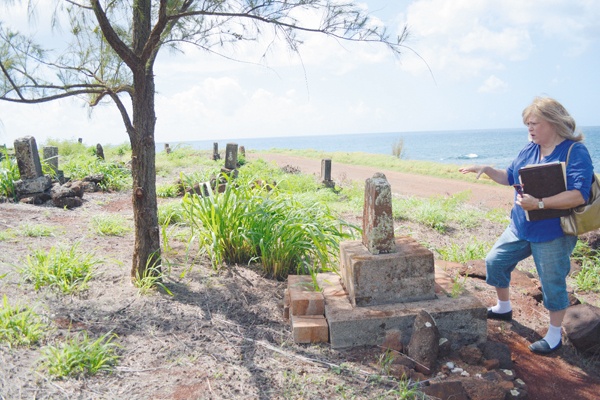ELEELE— Debrah Davis is at a crossroads.
It’s like when she was hacking through the grass and brush that grew like a forest at the Port Allen Cemetery, before she really grasped it was a cemetery.
She never knew which way she was turning then, either.
But then she’d move just a little bit in the Johnson grass taller than humans and trip over a gravestone buried in brush, and she’d know that was the way to start going next.
“It was like an archeological project,” Davis said, touring the cemetery she is trying to resurrect that’s has long fallen into disrepair. “You had no sense, you couldn’t see anything.”
It’s an archeological project that broke her weedeater — destroyed it in fact, rather quickly.
“No chance,” Davis said of when she pitted the lawn tool against the decades-old weeds.
So she bought a sickle.
“It’s huge,” she said of her new, old-school tool. “My shoulders still hurt.”
But it worked, too, and Davis removed the back seats of her van so she could haul the ripped-up grass away.
And as slowly and steadily as ocean breeze, the old McBryde Sugar Co. cemetery appeared. Some of the headstones, with Japanese and Chinese markings, were felled. Others stood unevenly. But it was a cemetery.
“I want to know who’s here?” Davis said of the old plantation workers buried near their old work place. “You have all these people here and you don’t know who they are.”
They’d traveled to the island for work when the sugar industry exploded at the end of the 19th century. That much has been documented in historical pieces, such as “Guardian of the Sea, Jizo in Hawaii,” by John Clark.
The book, which first peaked Davis’s interest in the cemetery partly because she lives nearby in Eleele, details how 15 work camps circled the cemetery in the heart of sugar production years. It describes the statues of Jizos that were built to overlook the chapel where Buddhist priests conducted burial services.
“Death was practically an everyday affair,” Clark wrote. “Some days 5 or 6 at a time.”
A Christian side of the cemetery sits on the 3.5-acre plot as well.
As soon as Davis began clearing the site in early July, she networked across the island to see if anyone could help, or anything more could be done.
Who was there? She wondered.
The property, according to Davis’s records, is owned by McBryde’s parent company, Alexander and Baldwin Inc. A cemetery association had been set up to care for the land, Davis said the company told her, but the members have since passed on. A spokesperson for the parent company didn’t return messages from The Garden Island Monday.
Davis has copies of some of the association members’ obituaries, and letters to their possible family members have been ignored or returned. Davis wants ask the National Register of Historic Places and see if she can get the place listed as a historical site. With that could come grant money, manpower, help.
Representatives from the state’s preservation office, which works with the National Register, didn’t return messages Monday. The register’s website says cemeteries aren’t usually considered for historic designations because they typically aren’t “significant in American history, architecture, archeology, engineering, and culture.”
So that’s where Davis is at. Those are the crossroads.
“There’s a lot of work that needs to be done,” she said. “It’s more than I can do myself.”
But she’s not down.
When she first came to the plot overlooking the ocean near Glass Beach, she couldn’t make out one headstone in the brush. Now, she’s cleared about one-third of the cemetery, and it’s unmistakably that — a cemetery. Sometimes, tourists or hikers stop and offer her encouragement.
“I think it’d be cool,” said Amanda Rosenthal, of Kalaheo, hiking the area last week, on the prospect of the place into a cleaned-up, if not protected cemetery. Right now “it’s a dump, it’s a cemetery, it’s kind of random.”
And Kauai County, though never an owner, said it could see if it could help.
George Ahlgren, the county’s Parks Maintenance Operations chief, said he would speak to contacts, such as community volunteers, to see if there might be opportunities to assist.
In the meantime, it’s been a long ride, Davis said, and who knows where it will end.
She’s already busted the weedeater, she’s worn through two pairs of gloves, the pollen and dust have murdered her sinuses and the grass is so thick with broken glass and trash, it’s dangerous to pick, which means the Boys Scouts can’t be called upon without liability insurance, which Davis doesn’t have.
But it’s been fun.
Every turn was an adventure, every yanked weed revealed something from the past.
“I loved it,” Davis said of the sometimes 10-hour days clearing brush. “I loved doing it. Can’t you see? Each day was a discovery.”
Info: email mcbrydesugarplantationcemetery@yahoo.com, or search on Facebook.



